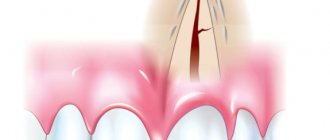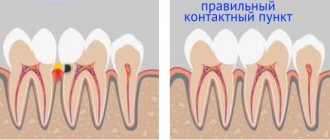Modern dentistry has a large arsenal of high-quality materials for filling teeth. What kind of filling should I put in order to reliably preserve the dental crown from destruction - plastic or ceramic, silicate or cement, chemical or light? Let's take a closer look at the different types of filling material and answer the question which filling is better.
Popular dental materials
Fillings are divided into permanent and temporary. A permanent one is placed when there is minor damage to the tooth crown, a temporary one is used for long-term complex treatment or diagnostics. A temporary filling is also used to protect medicinal compounds during dental treatment: a medicinal compound is placed under it.
The materials from which fillings are made are divided into several types:
- cement, silicate;
- plastic;
- metal, amalgam;
- ceramics;
- composites.
Depending on the material used, fillings are divided into several main types:
- cement;
- composite;
- compomers.
The dental industry also produces other types of fillings - plastic, metal and ceramic.
The most durable material is made from light-curing composite. Such fillings are expensive, but the high price justifies the long service life. The fillings look aesthetically pleasing and have the ability to change their shade with changes in lighting.
The most popular material is dental cement. These fillings are still in demand among patients due to their low cost, high adhesion and strength. The fillings literally stick to the surface of the crown and do not form air gaps.
Cement materials
Cement differs significantly from composite in its lower hardness, however, it is able to protect the tooth from repeated carious development. A disadvantage is the high density of cement compared to tooth tissue: over time, this contributes to the thinning of the crown surface adjacent to the filling.
Cement compositions have three subtypes, according to additives to the main ingredient:
- silicate;
- phosphate;
- glass ionomer.
Silicate compounds are the oldest of all. The material contains special glass mixed with phosphoric acids. The silicate composition has a different release of fluoride, which prevents the development of dental caries. The harmfulness of the material lies in its aggressive phosphoric acid, which destroys the pulp. To neutralize the effect of acid on the pulp tissue, a special gasket made of safe substances was installed.
Phosphate compounds are characterized by fragility and fragility, weak adhesion (adhesion to tooth tissue), and high abrasion. The peculiarity of these fillings is their high toxicity, which provokes the proliferation of aggressive bacteria. This substance (phosphate) does not protect well against the re-development of caries.
Glass ionomer cement is used to treat children. The substance is as close in texture as possible to dental tissue, has high adhesive characteristics and safety. The glass ionomer is illuminated with a special ultraviolet lamp, which promotes rapid hardening of the material and high-quality tooth protection from infection. The advantages of this material include the fluoride contained in the composition, which protects against the development of recurrent caries.
The disadvantages include fragility - softness and instability of the composition. In modern dentistry, strengthened glass ionomer is used, the composition of which is supplemented with metal or ceramic particles. This material is used for filling chewing molars; it is most resistant to abrasion. The last word in the development of dental materials is the production of nanoionomer, which reliably protects dental tissue from infection and the development of caries.
How does a chemical filling differ from a light filling?
When a patient goes to a public dental clinic with a medical insurance policy to get a filling, the doctor may offer him to “pay extra for a light filling.” This often causes misunderstanding among the patient and is a source of conflict situations. What's the matter here? Let's try to figure it out in this article.
Today's state guarantee program in Moscow and some other regions of the country clearly divides fillings according to the class of material used. Fillings made of cement and a chemically cured composite are installed free of charge, while fillings made of a “light” composite, which are installed using a special lamp with blue light, are installed at the expense of citizens, i.e. paid. In what cases can you limit yourself to a free chemical filling, and when is it worth paying extra for a light filling?
To understand the difference between these technologies, let’s look at the history of the development of dental materials for restoring hard dental tissues. Until the middle of the last century, the most common material for filling teeth was amalgam - a mixture of silver, mercury and other metals. Such metal fillings are still widely installed in many foreign countries – in budget dentistry. In our country, amalgam was abandoned in the 90s in favor of composites and cements, which at that time had already proven their effectiveness thanks to the development of technology.
Cements
So-called glass ionomer cements are widely used in modern dentistry. They are a mixture of powder - finely ground glass and liquid - organic acid or water. These two components are mixed, the resulting mixture is filled with a carious cavity, the liquid reacts with the environment, and the filling becomes solid.
Cements have many positive qualities:
- biocompatibility with dental tissues
- release of fluoride ions, which helps prevent secondary caries
- no material shrinkage
- matching teeth color
- quick placement of a filling without the use of adhesives (“glue” for fillings)
- low cost
However, despite all the positive properties, they also have their significant limitations:
- the adhesion of cements is approximately 10 times lower than that of composites, so fillings made from cements fall out more often;
- cements are not strong enough, they cannot restore the surfaces of chewing teeth;
- cements have a liquid consistency, they cannot be used to restore the missing part of a tooth, they can only fill cavities;
- cements are opaque and cannot be used for fillings on the front teeth, since such fillings will always be visible.
Cements are often used as a cushioning material for composites when filling large cavities (biocompatibility, no shrinkage). They are widely used in pediatric dentistry on baby teeth, as well as for any temporary fillings. With the help of cements, it is possible to place small, full-fledged fillings where there are no chewing loads, for example, in places where teeth touch in cases of shallow caries.
In all other cases, cement fillings are precisely the “budget” option - fast and free. You can judge the quality for yourself when such a filling falls out or crumbles.
Chemical composites
The invention of the acid etching technique (Buonocore, 1965) and the use of Bis-GMA monomer as a component of the filling material (Bowen, 1962) ushered in the “age of adhesive dentistry.” The first chemical composites appeared in the mid-60s of the last century. At that time, composite materials did not yet have particularly outstanding qualities compared to cements and plastics, so their use was limited. However, composites have shown higher strength and higher rates of adhesion to dental tissues due to the use of adhesives.
The widespread use of composite materials began at the turn of the 1980s, when light-curing materials appeared. The advantage of light-based materials over chemically cured composites quickly became obvious, and therefore many manufacturers of dental materials closed the production of chemical composites and completely switched to the production of light-cured ones. All scientific developments in the field of chemical composites were curtailed in favor of “light”. It is safe to say that luminous composite materials have replaced chemically cured composites.
Today, chemical composites are a dead-end branch of evolution. These are materials developed in the 70s of the last century. Most modern dental clinics, both abroad and in Russia, do not use chemical composites.
The only advantage of chemical composites is their lower price, due to which they have become, in addition to cements, another “budget” material. However, the significant disadvantages of chemical composites give reason to think about whether it is worth “ruining” a tooth with a chemical filling or is it better to find funds and pay extra for a light one.
The adhesion of chemical composites is several times lower than that of light composites; accordingly, fillings will fall out. The main problem of all composites is shrinkage during polymerization, which leads to disruption of the marginal seal and separation of the filling in the area of the bottom of the cavity, which, in turn, leads to inflammation of the pulp - pulpitis.
Chemical composites could be used for very small fillings, but the thing is that in adults there are practically no small cavities. A small black dot on the surface of a tooth, like the tip of an iceberg, hides a significant amount of carious tissue that requires removal.
The use of chemical composites in pediatric dentistry is also inappropriate, since it is better to use modern glass ionomer cements on primary teeth.
Thus, placing a filling made of a chemical composite is nothing more than the first step towards further destruction and loss of the tooth. That's the whole "budget" for you.
Light-curing composites
Luminous composites have been the most common filling material worldwide for many years. In the 1980s, materials with different sizes of filler particles appeared, intended for filling different groups of teeth: macrofilled (macrophilic), microfilled (microphilic), hybrid. In the 90s, all manufacturing companies worked on the development of universal filling materials. With the advent of “nano” technologies, truly universal materials – nanohybrids – have become available to dentists. Today, such composites are available in every dental office.
The main problem of any composite materials, shrinkage during polymerization, was solved by applying the material in small portions and exposing it to light. As you understand, this is impossible with chemically cured composites, since the patient would have to sit for several minutes with his mouth open, waiting for the next portion of the material to harden.
Light composites today are often called restoration materials rather than filling materials. With their help, you can not only place fillings, but also carry out any complex aesthetic and functional restorations. The technology of curing the material with light has turned dentists, who previously only placed fillings, into artists and sculptors. Now they can select materials based on color and transparency, combining them with each other. They can restore even completely destroyed teeth, repair old fillings and restorations, turn crooked teeth, restore the surfaces of front teeth and much more.
Undoubtedly, working with light composite materials requires a highly qualified dentist, therefore, if you are interested in aesthetic restoration, carefully choose a doctor, focusing on examples of his work and recommendations from friends.
To summarize, we can provide a comparative table of the properties of chemical and light curing composite materials.
Chemical composite
- Can be applied in only one layer - high shrinkage, caries develops under the filling, fillings fall out
- Lack of adhesion to dentin, adhesion only to enamel
- You can only fill cavities
- When mixing two pastes, the properties of the material deteriorate under the influence of oxygen
- You can use only one shade of the material - HC is not applicable for front teeth
- The adhesive and the material itself were developed in the 1970s
Light composite
- Can be applied in small portions to reduce shrinkage, the service life of the filling is 10 years or more
- The presence of special primers and adhesives for dentin, the adhesion force to enamel is higher than that of CC
- Everything can be restored – even missing parts of the tooth
- The material in the form of a single paste is removed from the syringe
- You can combine different shades of material - for any group of teeth
- Lighting materials have progressed over the past 30-40 years
As mentioned above, chemical composites have, perhaps, the only advantage over light ones - a lower price. That is why they became material for the budget. Insurance companies do not pay for more expensive lighting materials. Vivat insurance medicine!
The second “advantage” of chemical materials is faster work with them. Indeed, chemical fillings are installed quickly, the material is applied in one portion, and there is no need to expose it to light. This allows you to meet the 20 minutes allotted for an appointment with one patient in our valiant budget dentistry. But the question is - how long will such a filling last - a month? At best, six months to a year. What then? Grind the tooth again, and when there is nothing left to grind, remove the tooth. Then prosthetics with grinding of adjacent teeth, gradual loosening of the supporting teeth, over time - removal of the remaining teeth, and removable dentures at the age of 50-60 years. But that is not all. As a result of wearing removable dentures, there is atrophy of the alveolar ridge, a decrease in facial height and an senile grimace at 60-70 years of age. Are you happy with this prospect? Then continue to receive treatment at free dentistry and feel free to get chemical fillings.
For those who are concerned about the health and beauty of their teeth and face, we recommend that you take into account everything outlined in this article and, following the recommendations of your dentist, pay extra for a high-quality light filling. And also do not rush to remove diseased teeth, doing everything possible. to preserve and cure them.
YES. Polilov
Moscow, 2016
Composite compounds
Chemically cured composites were invented as an alternative to simple cement fillings. The composition of the composite includes porcelain, which gives greater strength to the cement. Also, according to their composition, composites are divided into three types:
- acrylic-containing;
- resin (epoxy);
- light-curing.
Of the listed compositions, the acrylic-containing composite has the greatest strength. These fillings are characterized by wear resistance, are little susceptible to abrasion, however, they have a toxic effect on the body. Due to toxicity, acrylic is contraindicated in many patients. Acrylic also often provokes the formation of pulpitis. Another negative feature of acrylic is its high absorbency, due to which the risk of caries increases significantly.
Resin composite material is not highly wear-resistant and durable, however, it is non-toxic and harmless to the body. The disadvantages of resin structures include a change in color after a few years: the fillings darken. Another feature of resin (epoxy) fillings is their excessive fragility: they can break off and be “eaten.” Therefore, it is better not to use epoxy composition on primary chewing molars. Epoxy composite also provokes the development of pulpitis, just like acrylic.
The light-curing composite gains its strength from a halogen lamp. They are also called photopolymer or solar-cured. The disadvantage of this material is the complexity of installation: polishing and grinding of the material is necessary. The filling must be polished every six months to maintain the original tone of the material.
What other disadvantages are typical for this material? These include the following properties of the filling:
- shrinkage after curing;
- possible chipping of the crown wall;
- poor-quality hardening of the material.
The filling can shrink up to five percent of its original volume, which significantly reduces the effectiveness of protecting the tooth. Even with slight shrinkage of the filling, there is a high probability of chipping of the adjacent wall of the dental crown. Due to the technical difficulties of working with a halogen lamp, the hardening of the material may be incomplete - only 70%.
An innovation in modern dentistry is a nanocomposite, the structure of which consists of tiny particles. The nanocomposite is characterized by high adhesion to tooth tissues, providing reliable protection against infection and the spread of caries.
Installation process
The process of installing a filling requires preparatory preparation. To do this, the dentist cleans the carious cavity from dead dentin tissue with the following treatment of the cavity.
The installation of an ordinary filling, as well as a light filling, occurs in stages:
- After cleaning out the caries, the unhealthy element is isolated from surrounding tissues using a cotton pad or latex materials. A saliva ejector is installed in the oral cavity;
- the cleaned cavity is treated with antimicrobial compounds - pastes or acid-containing liquids. Next, the oral cavity is dried using massive air pressure;
- a composite is selected - temporary or permanent. Material installed on a permanent base can withstand more than 10 years, and temporary composites are simply removed and the longest period of their use is 2-3 weeks. Temporary fillings are often installed in the presence of an inflammatory process in the oral cavity and are removed after the unpleasant symptoms disappear. An indication for the installation of temporary material is also depulpation, after which there is a likely risk of developing a re-infectious process;
- In case of moderate or deep caries, insulating pads are used during tooth filling. Such measures help to avoid infection of healthy dental tissues;
- installation of filling material for deep caries occurs under local anesthesia;
- After the material has hardened, it must be polished. To check the turning properties, carbon paper is used;
- At the last step of filling, the treated area is polished.
The procedure for installing a light seal differs slightly from the above method and contains the following procedures:
- preparing the affected element for filling and examining the oral cavity for the presence of damaged parts;
- performing local anesthesia;
- when the carious process is advanced, the pulp chamber is opened and the dentinal tubules are cleaned;
- sealing canals with gutta-percha;
- selection of a composite taking into account the natural color of tooth enamel;
- grinding down a carious cavity using a burr;
- installation of a rubber dam or saliva ejector in the oral cavity, isolation of the damaged element from surrounding tissues, drying of the element;
- application of orthophosphoric acid to the tooth. The substance helps open the pores of dentin and loosen it. Thanks to this measure, the best adhesion of the composite to the tissue (the totality of various and interacting tissues form organs)
of the element is ensured; - installation of filling material. The composite is applied into the cavity in layers, which ensures the best filling of all sections. Any layer is illuminated with ultraviolet light for 60 seconds.
- grinding and processing the surface of the filling after it hardens;
- coating of the composite with fluorine-containing varnish. The product secures the outer side of the tooth and the line of connection between the tissues of the element and the filling material.
Light and regular fillings are installed in one visit to the dentist.
In order for the photopolymer filling to last as long as possible, follow the following advice from the doctor:
- do not consume coloring products (coffee, beet juice, tea) within 24 hours after the dental procedure;
- the diet is enriched with fruits and cereals, this further strengthens the composite;
- Do not eat for 2 hours after filling.
Plastic, metal and ceramic compounds
Plastic fillings are also at the peak of popularity, also due to their low price. Plastic has many disadvantages:
- gives significant shrinkage after curing;
- changes its color over time;
- quickly wears out and becomes unusable;
- poorly protects against secondary caries.
Important! Cement and plastic fillings are placed in free dental clinics.
Ceramic compositions
The distinctive characteristics of this material are high strength, lack of shrinkage and aesthetics. Ceramics does not darken during use and is not painted. In modern dentistry, ceramics is considered an almost ideal filling material. Types of ceramics include:
- transparent material;
- pressed material;
- metal ceramics.
The disadvantages include the difficulty of installation: the composition fills the hole in the tooth, like an inlay. The inlay is formed using an impression of a previously sanitized tooth.
Metal alloys
Amalgam material includes a mercury compound along with silver. The dangers of exposure to mercury in the body pose a certain health risk. The advantage of amalgam is its long service life and abrasion resistance.
Another disadvantage of this material is expansion during hardening. If the dentist does not correctly calculate the volume of the filling, the possibility of slight destruction of the crown cannot be ruled out.
Due to the unaesthetic appearance of metal structures, they are used on back teeth or the hidden surface of the crown.
Which material to prefer
The dental compositions described above have their own characteristics, advantages and disadvantages. Which filling do you prefer? Which is better - light or chemical (ordinary)? The choice will depend on financial capabilities and the location of the tooth in the oral cavity - posterior molar or frontal.
It is preferable to place fillings made of durable, indelible compositions on posterior chewing molars. For example, metal, glass ionomer or nanocomposite materials.
If we consider from an aesthetic point of view, it is better to put light or ceramic fillings on the front teeth, which are identical to tooth enamel and are invisible when smiling. Light dental products are characterized by a certain fragility, and therefore cannot withstand heavy chewing load on the rear molars.
To restore a chipped or damaged tooth in the front rows, light fillings are used. Using a composite material, you can completely restore the shape of a tooth, which will look organic. A distinctive feature of the light composite is the versatility of choosing a color to match the tone of the natural enamel of the teeth.
If we consider the quality of the composition from the standpoint of durability, then the most durable materials are metal and photocomposite - a service life of more than ten years. All other trains last from four to five years.
Sources used:
- Klyomin V. A., Borisenko A. V., Ishchenko P. V. Combined dental fillings. MIA, 2008
- Practical therapeutic dentistry" (Nikolaev A.)
- Scheller-Sheridan C (8 May 2013). Basic Guide to Dental Materials. John Wiley & Sons.
- https://www.dentalhealth.ie/
Types of fillings
Dental fillings are distinguished by the time of use and the quality of the material. Temporary fillings are installed for a short period; they close the tooth cavity until the next visit to the dentist. Permanent ones are installed for a long period (1-5 years). They are installed only on sanitized surfaces.
Purpose of permanent fillings:
- prevent harmful microorganisms from entering the deep layers of dentin;
- prevent the development of secondary caries;
- help recreate the shape of the tooth.
When using high-quality materials installed in compliance with the necessary standards, the filled tooth will not differ from other units in the dentition.











